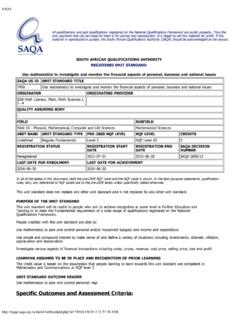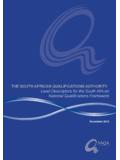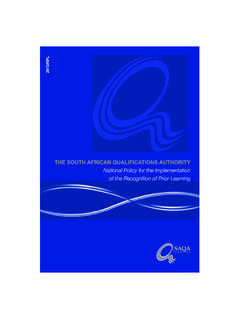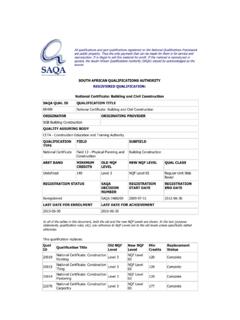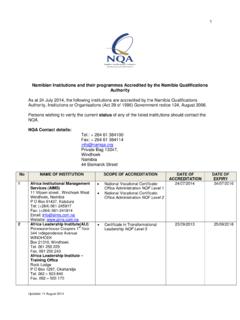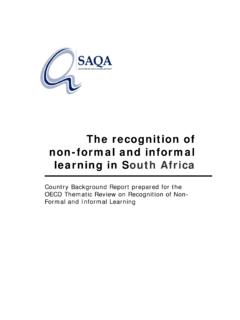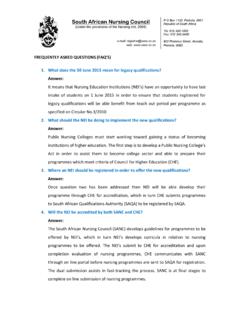Transcription of SOUTH AFRICAN QUALIFICATIONS AUTHORITY …
1 SAQAAll QUALIFICATIONS and part QUALIFICATIONS registered on the National QUALIFICATIONS Framework are public property. Thus theonly payment that can be made for them is for service and reproduction. It is illegal to sell this material for profit. If thematerial is reproduced or quoted, the SOUTH AFRICAN QUALIFICATIONS AUTHORITY (SAQA) should be acknowledged as the AFRICAN QUALIFICATIONS AUTHORITY REGISTERED UNIT STANDARD: Apply occupational health, safety and environmental principles SAQA USIDUNIT STANDARD TITLE113852 Apply occupational health, safety and environmental principles ORIGINATORORIGINATING PROVIDERSGB Transport and LogisticsOperations QUALITY ASSURING BODY- FIELDSUBFIELDF ield 11 - ServicesTransport.
2 Operations and Logistics ABETBANDUNIT STANDARDTYPEPRE-2009 NQF LEVELNQF LEVELCREDITSU ndefined Regular Level 3 NQF Level 03 10 REGISTRATION STATUSREGISTRATION STARTDATEREGISTRATION ENDDATESAQA DECISIONNUMBERR eregistered 2012-07-01 2015-06-30 SAQA 0695/12 LAST DATE FOR ENROLMENTLAST DATE FOR ACHIEVEMENT2016-06-30 2019-06-30 In all of the tables in this document, both the pre-2009 NQF Level and the NQF Level is shown. In the text (purpose statements, qualificationrules, etc), any references to NQF Levels are to the pre-2009 levels unless specifically stated otherwise. This unit standard does not replace any other unit standard and is not replaced by any other unit standard.
3 PURPOSE OF THE UNIT STANDARD Learners acquiring this standard will be learning towards obtaining a national qualification or are working within a health andsafety environment, where acquisition of competence against this standard will add value to learner`s job, or chances of findingemployment. The qualifying learner is capable of: Identifying hazards Evaluating hazards Controlling hazards Explaining and using relevant legislation and regulations Gathering and organising occupational health, safety and environmental information from the workplace Carrying out occupational health and safety training LEARNING ASSUMED TO BE IN PLACE AND RECOGNITION OF PRIOR LEARNING Learners accessing this unit standard / qualification will have demonstrated competence against adequate reading and writingskills as well as knowledge of the workplace in terms of the jobs performed by people on a team.
4 Procedures required of themand experience of dealing with problems and processes in the workplace. UNIT STANDARD RANGE Activities will be conducted in the immediate work environment. Legislation and regulation will include: The Occupational Health and Safety Act (OHS), Compensation for Occupational Injuriesand Diseases (COID) and relevant sections of the Labour Relations, Basic Conditions of Employment, Equity Acts andSAQA environmental legislation. Gathered information will concern workplace hazards, budgeting, absenteeism and training and occupational incident statistics,amongst others.
5 Carry out informal training with small, mixed gender and language groups. Specific Outcomes and Assessment Criteria:SPECIFIC OUTCOME 1 Identify hazards. ASSESSMENT CRITERIA ASSESSMENT CRITERION 1 hazards are identified and categorised according to specific area, job category, work procedure, machinery orsubstances used. ASSESSMENT CRITERION 2 inspections are undertaken in specific work CRITERION 3 on specific Occupational Risk Exposure Profiles is contributed (OREP) in CRITERION 4 and categories of employees are assisted in contributing to their CRITERION 5 are assisted in hazard identification (informal on the job hazard education/training for other employees).
6 ASSESSMENT CRITERION 6 identification is communicated in specific areas and jobs with employees and CRITERION 7 links between work, health, safety and the environment are explained (public safety).SPECIFIC OUTCOME 2 Evaluate and report hazards. ASSESSMENT CRITERIA ASSESSMENT CRITERION 1 are evaluated and prioritised (in particular area, work procedures and job categories) according to the risk of exposureand the risk of detrimental health outcome (occupational injury or disease). ASSESSMENT CRITERION 2 on hazards drafted in H&S structures are reported on and CRITERION 3 in incident investigations is CRITERION 4 investigation outcomes are communicated with CRITERION 5 rudimentary knowledge of Risk Assessment ( ) and ability to contribute information to is CRITERION 6 are informed of hazard evaluation activities, results and OUTCOME 3 Apply preventative measures (including training) in the workplace.
7 ASSESSMENT CRITERIA ASSESSMENT CRITERION 1 measures in place are identified and CRITERION 2 principle of the hierarchy of control measures to the workplace are CRITERION 3 control measures are communicated, in specific areas and jobs with employees and CRITERION 4 control measures in place for particular area, work procedure, machinery or substance are described, evaluated andreported on. ASSESSMENT CRITERION 5 , on the job peer learning is facilitated from shared CRITERION 6 OH&S training materials and resources are identified and CRITERION 7 OH&S training is CRITERION 8 training needs are OUTCOME 4 Explain, use and comply with relevant legislation and regulations.
8 ASSESSMENT CRITERIA ASSESSMENT CRITERION 1 responsibilities, duties and rights of individuals in the workplace and the relevant internal and external bodies aredescribed correctly. ASSESSMENT CRITERION 2 OH&S information relevant to the workplace are located and CRITERION 3 COID Act rights and procedures are explained and CRITERION 4 are informed of their OH&S CRITERION 5 are advised of the duties, functions and responsibilities of the employer and the H&S role players in the CRITERION 6 is utilised from the legislation to perform responsibilities/duties to CRITERION 7 ` representatives on OH&S related issues are CRITERION 8 SAQA8.
9 The Department of Labour (DoL) representatives, OH practitioners and occupational hygienists responsible for measuring orundertaking surveillance programmes are engaged with ASSESSMENT CRITERION 9 compliance with regulations and legislation is assessed and reported OUTCOME 5 Gather and organise OHS information from the workplace. ASSESSMENT CRITERIA ASSESSMENT CRITERION 1 and interviews with employees are conducted to gather OH&S needs and CRITERION 2 from reports, meetings and inspections is summarised to address H&S issues with affected STANDARD ACCREDITATION AND MODERATION OPTIONS An individual wishing to be assessed (including through RPL) against this unit standard may apply to an assessment agency,assessor or provider institution accredited by the relevant ETQA Anyone assessing a learner against this unit standard must be registered as an assessor with the relevant ETQA.
10 Any institution offering learning that will enable achievement of this unit standard or assessing this unit standard must beaccredited as a provider with the relevant ETQA Moderation of assessment will be conducted by the relevant ETQA at its discretion. UNIT STANDARD ESSENTIAL EMBEDDED KNOWLEDGE General Knowledge of occupational health and hygiene and the effects of injury and disease Observational, listening and inquiry knowledge and skills Networking knowledge and skills Report writing knowledge and skills UNIT STANDARD DEVELOPMENTAL OUTCOME N/A UNIT STANDARD LINKAGES N/A Critical Cross-field Outcomes (CCFO):UNIT STANDARD CCFO WORKING Work effectively with others as a member of a team and organisation in the running of training groups.

